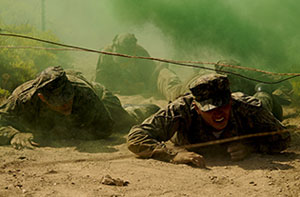Injury Prevention and Reduction


Biomedical basis for countermeasures that prevent and mitigate Warrior injury
MOMRP Injury Prevention and Reduction research develops models to predict the degree of injury from known threats, develops design guidelines and performance specifications for protective equipment, and identifies countermeasures to prevent or mitigate injury to the Warrior. Key threats addressed by this research area include blast overpressure, blunt and penetrating trauma, musculoskeletal and training injuries, and neurosensory injury. This program addresses thoracic and pulmonary injury protection through modeling blast and blunt trauma, protection that prevents or reduces neurosensory injury, develops validated standards for performance to assess return to duty, and training doctrine based on physiological mechanisms that underlie musculoskeletal injury that identify and mitigate injury risks.
Warriors are susceptible to physical, sometimes debilitating injuries. Head and neck injuries, including severe brain trauma, have been reported in one quarter of evacuated service members. In the past five years, Walter Reed Army Medical Center alone has surgically treated approximately 700 Warriors with moderate-to-severe visual injuries. Nearly 70,000 combat troops are collecting disability for tinnitus, and over 58,000 for hearing loss. Medical disability discharge rates have increased with 78 percent due to musculoskeletal injury. MOMRP research helps prevent physical injuries through development of injury prediction models, equipment design specifications and guidelines, health hazard assessment criteria, and strategies to reduce musculoskeletal injuries.
Working Groups that support Injury Prevention and Reduction research are:
- Hearing Loss and Vestibular Issues
- Musculoskeletal Injury
- Development of Exposure Standards for Repeated Blast Exposures



